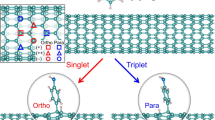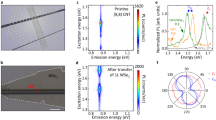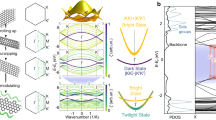Abstract
The introduction of sp3 defects into single-walled carbon nanotubes through covalent functionalization can generate new light-emitting states and thus dramatically expand their optical functionality. This may open up routes to enhanced imaging, photon upconversion, and room-temperature single-photon emission at telecom wavelengths. However, a significant challenge in harnessing this potential is that the nominally simple reaction chemistry of nanotube functionalization introduces a broad diversity of emitting states. Precisely defining a narrow band of emission energies necessitates constraining these states, which requires extreme selectivity in molecular binding configuration on the nanotube surface. We show here that such selectivity can be obtained through aryl functionalization of so-called ‘zigzag’ nanotube structures to achieve a threefold narrowing in emission bandwidth. Accompanying density functional theory modelling reveals that, because of the associated structural symmetry, the defect states become degenerate, thus limiting emission energies to a single narrow band. We show that this behaviour can only result from a predominant selectivity for ortho binding configurations of the aryl groups on the nanotube lattice.
This is a preview of subscription content, access via your institution
Access options
Access Nature and 54 other Nature Portfolio journals
Get Nature+, our best-value online-access subscription
$29.99 / 30 days
cancel any time
Subscribe to this journal
Receive 12 print issues and online access
$259.00 per year
only $21.58 per issue
Buy this article
- Purchase on Springer Link
- Instant access to full article PDF
Prices may be subject to local taxes which are calculated during checkout





Similar content being viewed by others
References
Michler, P. et al. Quantum correlation among photons from a single quantum dot at room temperature. Nature 406, 968–970 (2000).
Miyazawa, T. et al. Single-photon emission at 1.5 μm from an InAs/InP quantum dot with highly suppressed multi-photon emission probabilities. Appl. Phys. Lett. 109, 132106 (2016).
Srivastava, A. et al. Optically active quantum dots in monolayer WSe2. Nat. Nanotech. 10, 491–496 (2015).
He, Y.-M. et al. Single quantum emitters in monolayer semiconductors. Nat. Nanotech. 10, 497–501 (2015).
Koperski, M. et al. Single photon emitters in exfoliated WSe2 structures. Nat. Nanotech. 10, 503–506 (2015).
Chakraborty, C., Kinnischtzke, L., Goodfellow, K. M., Beams, R. & Vamivakas, A. N. Voltage-controlled quantum light from an atomically thin semiconductor. Nat. Nanotech. 10, 507–512 (2015).
Tran, T. T., Bray, K., Ford, M. J., Toth, M. & Aharonovich, I. Quantum emission from hexagonal boron nitride monolayers. Nat. Nanotech. 11, 37–41 (2016).
Hogele, A., Galland, C., Winger, M. & Imamoglu, A. Photon antibunching in the photoluminescence spectra of a single carbon nanotube. Phys. Rev. Lett. 100, 217401 (2008).
Walden-Newman, W., Sarpkaya, I. & Strauf, S. Quantum light signatures and nanosecond spectral diffusion from cavity-embedded carbon nanotubes. Nano Lett. 12, 1934–1941 (2012).
Hofmann, M. S. et al. Bright, long-lived, and coherent excitons in carbon nanotube quantum dots. Nat. Nanotech. 8, 502–505 (2013).
Ma, X., Hartmann, N. F., Baldwin, J. K. S., Doorn, S. K. & Htoon, H. Room-temperature single-photon generation from solitary dopants of carbon nanotubes. Nat. Nanotech. 10, 671–675 (2015).
He, X. et al. Tunable room-temperature single-photon emission at telecom wavelengths from sp 3 defects in carbon nanotubes. Nat. Photon. 11, 577–582 (2017).
Aharonovich, I., Englund, D. & Toth, M. Solid-state single-photon emitters. Nat. Photon. 10, 631–641 (2016).
Bachilo, S. M. et al. Structure-assigned optical spectra of single-walled carbon nanotubes. Science 298, 2361–2366 (2002).
Zheng, M. Sorting carbon nanotubes. Top. Curr. Chem. 375, 13 (2017).
Ghosh, S., Bachilo, S. M., Simonette, R. A., Beckingham, K. M. & Weisman, R. B. Oxygen doping modifies near-infrared band gaps in fluorescent single-walled carbon nanotubes. Science 330, 1656–1659 (2010).
Ma, X. et al. Electronic structure and chemical nature of oxygen dopant states in carbon nanotubes. ACS Nano 8, 10782–10789 (2014).
Kwon, H. et al. Molecularly tunable fluorescent quantum defects. J. Am. Chem. Soc. 138, 6878–6885 (2016).
Piao, Y. M. et al. Brightening of carbon nanotube photoluminescence through the incorporation of sp 3 defects. Nat. Chem. 5, 840–845 (2013).
Miyauchi, Y. et al. Brightening of excitons in carbon nanotubes on dimensionality modification. Nat. Photon. 7, 715–719 (2013).
Akizuki, N., Aota, S., Mouri, S., Matsuda, K. & Miyauchi, Y. Efficient near-infrared up-conversion photoluminescence in carbon nanotubes. Nat. Commun. 6, 8920 (2015).
He, X. et al. Low-temperature single carbon nanotube spectroscopy of sp 3 quantum defects. ACS Nano 11, 10785–10796 (2017).
Shiraki, T., Shiraishi, T., Juhász, G. & Nakashima, N. Emergence of new redshifted carbon nanotube photoluminescence based on proximal doped-site design. Sci. Rep. 6, 28393 (2016).
Maeda, Y. et al. Tuning of the photoluminescence and up-conversion photoluminescence properties of single-walled carbon nanotubes by chemical functionalization. Nanoscale 8, 16916–16921 (2016).
Gifford, B. J., Kilina, S., Htoon, H., Doorn, S. K. & Tretiak, S. Exciton localization and optical emission in aryl-functionalized carbon nanotubes. J. Phys. Chem. C 122, 1828–1838 (2017).
Strano, M. S. et al. Electronic structure control of single-walled carbon nanotube functionalization. Science 301, 1519–1522 (2003).
Niyogi, S. et al. Chemistry of single-walled carbon nanotubes. Acc. Chem. Res. 35, 1105–1113 (2002).
Bekyarova, E. et al. Effect of covalent chemistry on the electronic structure and properties of carbon nanotubes and graphene. Acc. Chem. Res. 46, 65–76 (2013).
Chua, C. K. & Pumera, M. Covalent chemistry on graphene. Chem. Soc. Rev. 42, 3222–3233 (2013).
Vora, P. M., Tu, X., Mele, E. J., Zheng, M. & Kikkawa, J. M. Chirality dependence of the K-momentum dark excitons in carbon nanotubes. Phys. Rev. B 81, 155123 (2010).
Niyogi, S., Densmore, C. G. & Doorn, S. K. Electrolyte tuning of surfactant interfacial behavior for enhanced density-based separations of single-walled carbon nanotubes. J. Am. Chem. Soc. 131, 1144–1153 (2009).
Duque, J. G., Densmore, C. G. & Doorn, S. K. Saturation of surfactant structure at the single-walled carbon nanotube surface. J. Am. Chem. Soc. 132, 16165–16175 (2010).
Tummala, N. R. & Striolo, A. SDS surfactants on carbon nanotubes: aggregate morphology. ACS Nano 3, 595–602 (2009).
Tu, X., Manohar, S., Jagota, A. & Zheng, M. DNA sequence motifs for structure-specific recognition and separation of carbon nanotubes. Nature 460, 250–253 (2009).
Yarotski, D. et al. Scanning tunneling microscopy of DNA-wrapped carbon nanotubes. Nano Lett. 9, 12–17 (2009).
Shiraki, T., Uchimura, S., Shiraishi, T., Onitsuka, H. & Nakashima, N. Near infrared photoluminescence modulation by defect site design using aryl isomers in locally functionalized single-walled carbon nanotubes. Chem. Commun. 53, 12544–12547 (2017).
Subbaiyan, N. K. et al. Role of surfactants and salt in aqueous two-phase separation of carbon nanotubes towards simple chirality isolation. ACS Nano 8, 1619–1628 (2014).
Yomogida, Y. et al. Industrial-scale separation of high-purity single-chirality single-wall carbon nanotubes for biological imaging. Nat. Commun. 7, 12056 (2016).
Ao, G., Streit, J. K., Fagan, J. A. & Zheng, M. Differentiating left- and right-handed carbon nanotubes by DNA. J. Am. Chem. Soc. 138, 16677–16685 (2016).
Streit, J. K., Fagan, J. A. & Zheng, M. A low energy route to DNA-wrapped carbon nanotubes via replacement of bile salt surfactants. Anal. Chem. 89, 10496–10503 (2017).
Hartmann, N. F. et al. Photoluminescence imaging of solitary dopant sites in covalently doped single-wall carbon nanotubes. Nanoscale 7, 20521–20530 (2015).
Hartmann, N. F. et al. Photoluminescence dynamics of aryls sp 3 defect states in single-walled carbon nanotubes. ACS Nano 10, 8355–8365 (2016).
Powell, L. R., Piao, Y. & Wang, Y. Optical excitation of carbon nanotubes drives localized diazonium reactions. J. Phys. Chem. Lett. 7, 3690–3694 (2016).
Sanchez, S. R., Bachilo, S. M., Kadria-Vili, Y., Lin, C. W. & Weisman, R. B. (n,m) specific absorption cross sections of single-walled carbon nanotubes measured by variance spectroscopy. Nano Lett. 16, 6903–6909 (2016).
Frisch, M. J et al. Gaussian 09 (Gaussian, Inc., 2009).
Yanai, T., Tew, D. P. & Handy, N. C. A new hybrid exchange–correlation functional using the Coulomb-attenuating method (CAM-B3LYP). Chem. Phys. Lett. 393, 51–57 (2004).
Hehre, W. J., Stewart, R. F. & Pople, J. A. Self-consistent molecular-orbital methods. I. Use of Gaussian expansions of Slater-type atomic orbitals. J. Chem. Phys. 51, 2657–2664 (1969).
Gifford, B. J. et al. Correction scheme for comparison of computed and experimental optical transition energies in functionalized single-walled carbon nanotubes. J. Phys. Chem. Lett. 9, 2460–2468 (2018).
Kilina, S., Ramirez, J. & Tretiak, S. Brightening of the lowest exciton in carbon nanotubes via chemical functionalization. Nano Lett. 12, 2306–2312 (2012).
Acknowledgements
This work was conducted in part at the Center for Integrated Nanotechnologies, a US Department of Energy, Office of Science user facility, and supported in part by the Center for Nonlinear Studies and by Los Alamos National Laboratory Directed Research and Development funds. S.K. acknowledges financial support from NSF Grant CHE-1413614 for studies of functionalized carbon nanotubes. For computational resources and administrative support, the authors thank the Center for Computationally Assisted Science and Technology (CCAST) at North Dakota State University. The authors also acknowledge the LANL Institutional Computing (IC) Program for providing computational resources. H.K. acknowledges support from JSPS KAKENHI grant no. JP25220602. Correspondence and requests for materials should be addressed to S.K.D. or S.T.
Author information
Authors and Affiliations
Contributions
S.K.D. conceived and designed the experiments. Nanotube separations, functionalization, and spectroscopic characterization were performed by A.S. with assistance from X.H. under the supervision of S.K.D. Single-nanotube spectroscopy was performed by X.H. under the supervision of H.H. Additional purified nanotube material was provided by G.A., M.Z. and H.K. Theoretical modelling was performed by B.J.G. under the supervision of S.T. and S.K. All authors contributed to the analysis and interpretation of results. A.S., B.J.G., S.T. and S.K.D. wrote the manuscript with assistance from all co-authors.
Corresponding authors
Ethics declarations
Competing interests
The authors declare no competing interests.
Additional information
Publisher’s note: Springer Nature remains neutral with regard to jurisdictional claims in published maps and institutional affiliations.
Supplementary information
Supplementary Information
Supplementary Figures 1–5, Supplementary Table 1, Supplementary Computational Methods
Rights and permissions
About this article
Cite this article
Saha, A., Gifford, B.J., He, X. et al. Narrow-band single-photon emission through selective aryl functionalization of zigzag carbon nanotubes. Nature Chem 10, 1089–1095 (2018). https://doi.org/10.1038/s41557-018-0126-4
Received:
Accepted:
Published:
Issue Date:
DOI: https://doi.org/10.1038/s41557-018-0126-4
This article is cited by
-
Chemomechanical modification of quantum emission in monolayer WSe2
Nature Communications (2023)
-
Photochemical spin-state control of binding configuration for tailoring organic color center emission in carbon nanotubes
Nature Communications (2022)
-
Formation of organic color centers in air-suspended carbon nanotubes using vapor-phase reaction
Nature Communications (2022)
-
Synthetic control over the binding configuration of luminescent sp3-defects in single-walled carbon nanotubes
Nature Communications (2021)
-
Enhancing near-infrared photoluminescence from single-walled carbon nanotubes by defect-engineering using benzoyl peroxide
Scientific Reports (2020)



